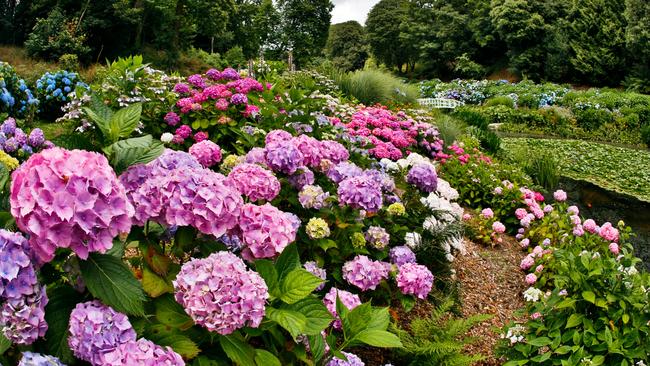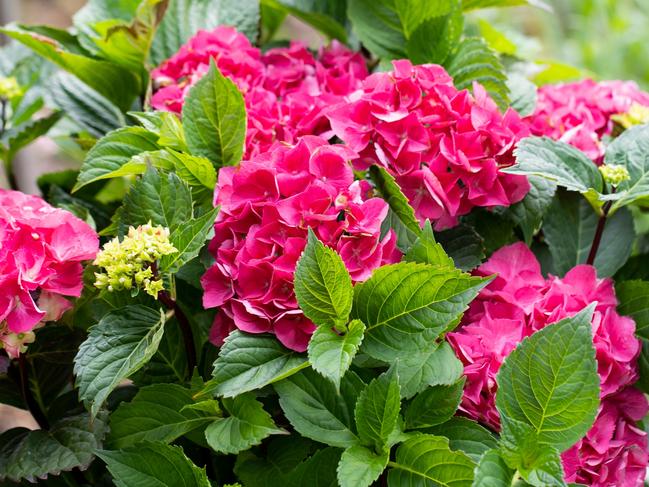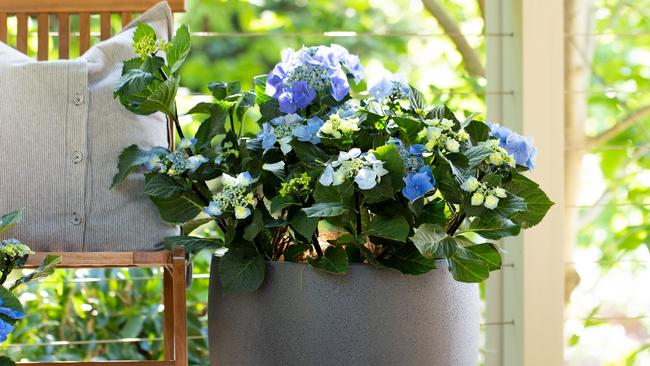How hydrangeas are making a fashionable comeback
Exciting new varieties, colours and styles have reinstated these worthy shrubs as the stars of the summer garden.

Hydrangeas are back in fashion. Boosted by exciting new varieties featuring different flower colours and styles, and new foliage colours, these worthy shrubs are stars of the summer garden and make excellent cut flowers.
The typical hydrangea (H. macrophylla) has generous balls of flowers in summer on a rounded, deciduous shrub, up to 2m tall. They flower blue in acidic soil, pink in alkaline soil, and mauve somewhere in the middle. Technically it is the amount of available aluminium (a function of soil pH) that causes the colour change. White varieties generally stay white, but can develop pale pink tones as they age. In addition to these “mophead” types there are elegant “lacecap” style hydrangeas, which have a flat centre of tiny, fertile flowers surrounded by a coronet of showy but sterile flowers.

Thanks to breeders around the world there are now so many more varieties. ‘Endless Summer’ hydrangeas repeat flower, unlike the usual one bloom per stem each year. If you prune off spent flowers, new ones develop, continuing over many months. The ‘Magical’ series of hydrangeas also flowers on old and new wood; it includes ‘Rubyred’ with unusual black-tinged leaves, and white ‘Pearl’ that ages to chartreuse. ‘Magical Revolution’ changes colour from pink or blue, transitioning through red to deep burgundy, with claims of flowering for 150 days. Compact and ideal for pots, it has improved resistance to sun, frost and rain.

The Obsidian Collection is named for their unique black stems. ‘White Knight’ has white, mophead blooms, ‘Storm Cloud’ has deep pink to dark purple mopheads, while ‘Black Lace’ is a lacecap. The compact You and Me series brings romantic, double-flowered forms for gardens or pots. The flower heads are large and prolific, in a range of colours: ‘Desire’ is mid-blue to pink, ‘Forever’ is paler and ‘Romance’ is stronger, while ‘Peace’ is pure white. The unusual dark purple/black foliage of ‘Tuxedo’ hydrangeas is a dynamic contrast to their large red or pink mophead flowers. Two other lace-caps are ‘Strawberries and Cream’, with deep pink flowers around a cream centre, and ‘Blueberries and Cream’ with dramatic cornflower blue flowers. Flowering time is a little earlier, from late spring.
Other species of hydrangeas have different charms. Oakleaf hydrangea (H. quercifolia) deserves to be more widely planted, offering handsome foliage that turns to glowing autumn colours on a 2m-tall shrub. Its large clusters of flowers are cone-shaped, starting creamy-white and ageing to pink. Panicle or peegee hydrangeas (H. paniculata) have smaller leaves and tolerate more sun. ‘Sundae Fraise’ is an outstanding variety, with long, pointed flower clusters that start green before turning white, and then become deeper pink as they mature into autumn; ‘Diamond Rouge’ develops even brighter red shades.
Q&A
How can we prune our yucca plants that are now too tall? My wife doesn’t want me to simply cut the trunk but I don’t see an alternative. Gary Lopez, Sydney
Only cutting them will make them shorter, but happily, yuccas respond very well to pruning. Cut as low as you want, where you want the new growth to come from – you should get two or three shoots from that point. You can also plant the tops you cut off and they will form roots, so these could be the replacement plants while your originals recover. Spring is the ideal time.
My ponytail palm (Beaucarnea recurvata) flowered about a year ago. Should I remove the spent flower spike to encourage growth? Craig Gumley, Perth
Unless you want to collect seeds, cut out the old spike at the base. Only female plants can produce seeds if their (pink) flowers are pollinated from a nearby male plant’s (cream) flowers. Not really palms, ponytails only flower when mature, and then every summer.
What signature trees (like pencil pines) could we grow in two large pots against an east-facing wall? Chris Oldrey, Hope Island, Queensland
Thuja ‘Smaragd’ is a neat, cone-shaped conifer to 2m tall with flattened fans of foliage, ideal for pots. Lady finger palm (Rhapis) is elegant and takes morning sun; rubber trees (Ficus elastica) in different leaf colours are in vogue. Magnolia ‘Teddy Bear’ has a compact shape and handsome leaves but needs reliable watering. Pots against walls should be turned by a quarter every month to prevent dieback on the wall side.
Send your questions to: helenyoungtwig@gmail.com or Helen Young, PO Box 3098, Willoughby North, NSW 2068. The best question for December/January wins $200 worth of Neutrog products including POPUL8, Kahoona, Gyganic and Seamungus.


To join the conversation, please log in. Don't have an account? Register
Join the conversation, you are commenting as Logout